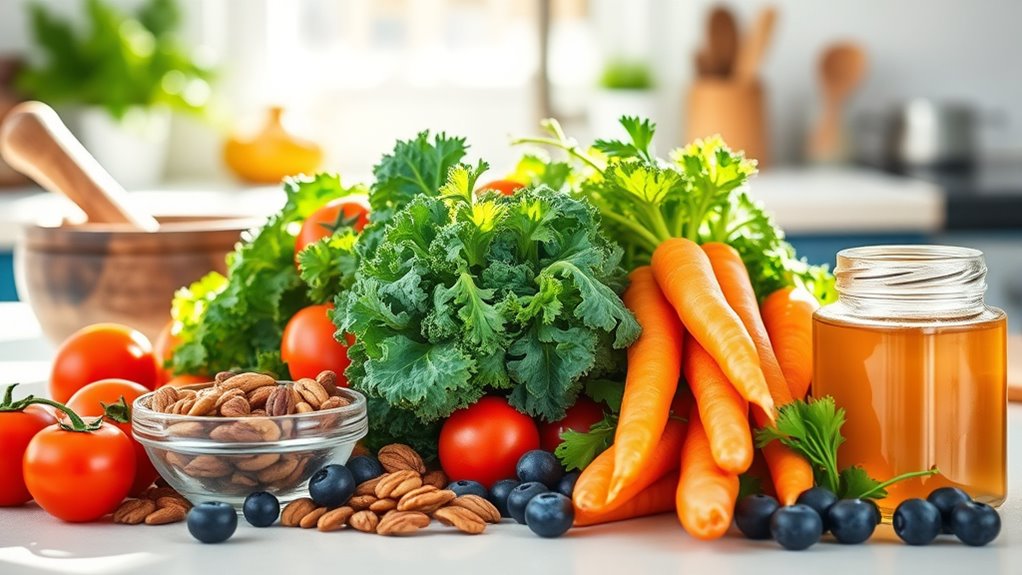To support healthy aging, focus on filling your plate with colorful fruits and vegetables, whole grains, and nutrient-rich proteins. Choose foods low in saturated fats, added sugars, and sodium by checking labels carefully. Adapt your diet to account for age-related changes, ensuring adequate hydration and nutrient intake. Opt for affordable options like frozen produce and bulk staples, and consider professional advice to customize your nutrition plan. Keep exploring how simple adjustments can boost your liveliness and well-being.
Key Takeaways
- Prioritize a colorful, balanced diet rich in fruits, vegetables, whole grains, and lean proteins to support nutrient diversity and immune health.
- Stay well-hydrated and include nutrient-dense foods to compensate for age-related decreases in appetite and taste.
- Incorporate variety and adapt nutrient intake to maintain muscle mass, bone strength, and overall vitality.
- Use budget-friendly options like frozen produce, store brands, and meal planning to ensure consistent access to nutritious foods.
- Consult healthcare professionals for personalized dietary guidance addressing specific health needs and nutrient deficiencies.
Prioritize a Balanced and Colorful Plate
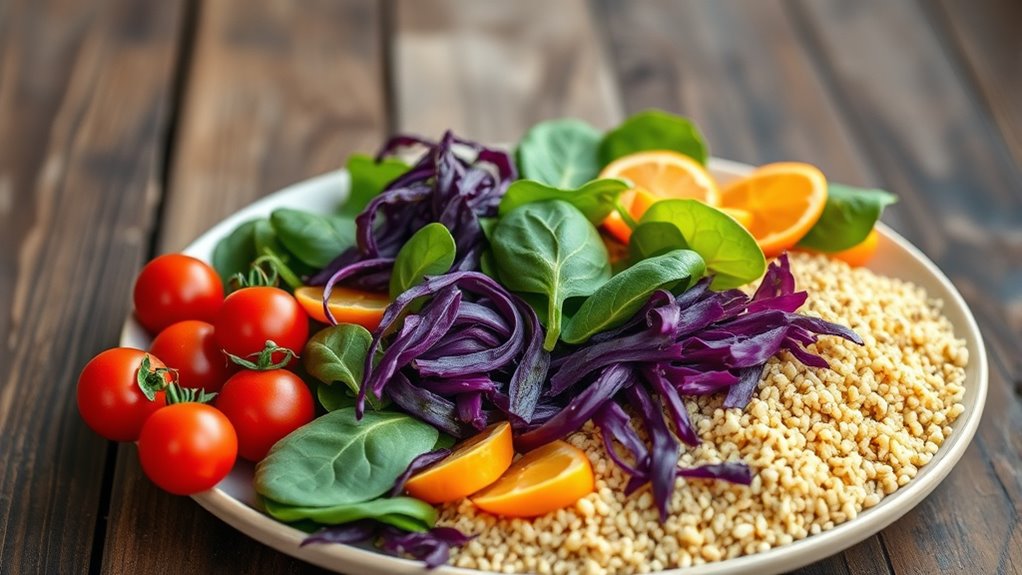
To support healthy aging, it’s essential to prioritize a balanced and colorful plate at every meal. A colorful plate ensures you get a variety of nutrients, antioxidants, and essential vitamins crucial for overall health.
Fill half your plate with fruits and vegetables like berries, carrots, and spinach to maximize nutrient intake. Incorporating whole grains such as brown rice, oats, or whole wheat bread can boost fiber and support digestion. Ensuring the quality of water is also vital since hydration influences overall health and well-being, especially as we age. Additionally, choosing nutrient-dense options can help prevent deficiencies and promote vitality. Paying attention to essential oils in your diet, like those with antimicrobial or anti-inflammatory properties, can further support your health as you age.
Fill half your plate with colorful fruits and vegetables to boost nutrients and support overall health.
Including lean proteins like fish, beans, or poultry helps maintain muscle mass and strength. By choosing nutrient-dense options and limiting processed foods, you create a balanced diet that promotes healthy aging. Maintaining proper water quality is also vital since hydration influences overall health and well-being, especially as we age.
A vibrant, balanced plate not only enhances your nutrition but also makes meals more appealing and satisfying, supporting your long-term well-being. Additionally, understanding the importance of contrast ratio in visual displays can help you better appreciate how vibrant and crisp your meals appear on well-calibrated screens.
Incorporate a Variety of Nutrient-Dense Foods
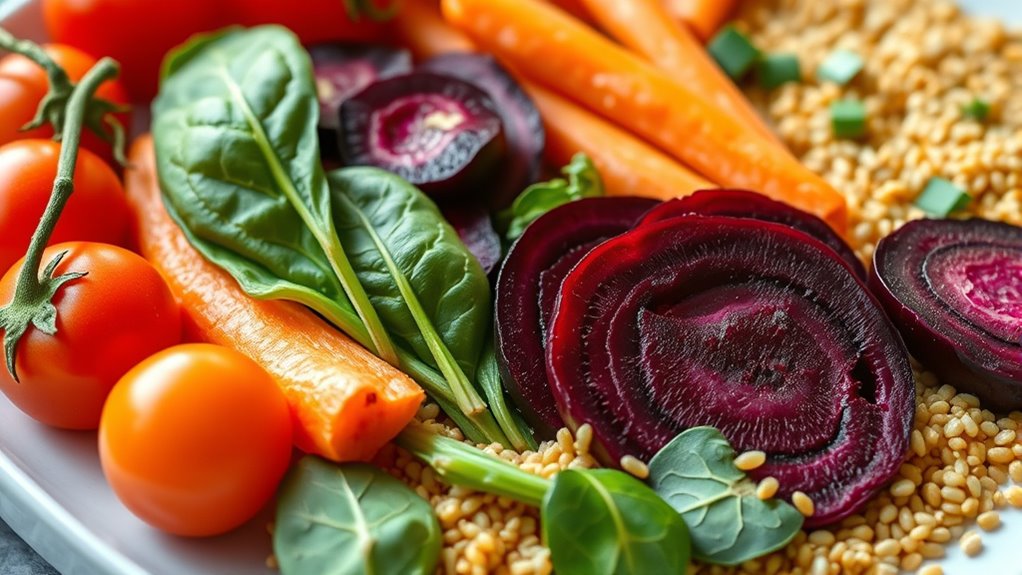
To support healthy aging, you should include a colorful mix of fruits and vegetables, like berries and leafy greens, to obtain a wide range of antioxidants.
Incorporate whole grains such as oats and brown rice to boost your fiber intake and aid digestion.
Varying your protein sources and healthy fats ensures you meet your nutritional needs and promote overall well-being.
Colorful Fruit Options
Incorporating a variety of colorful fruits into your diet guarantees you get a broad spectrum of essential nutrients. Colorful fruits like blueberries, raspberries, and apples provide antioxidants, vitamins, and phytochemicals that support healthy aging.
Fruits with deep orange and red hues—such as carrots and tomatoes—contain carotenoids like beta carotene and lycopene, which help combat oxidative stress and UV damage. These compounds are best preserved when consuming whole, fresh fruits rather than processed options.
Consuming a spectrum of colors ensures you get different phytochemicals that boost immune function, promote skin health, and reduce inflammation. Including natural materials found in these fruits can also enhance their nutritional benefits.
Choosing whole, fresh fruits maximizes nutrient density compared to processed options, making them the best choice for supporting well-being. A diverse color palette of fruits can provide a wider array of beneficial nutrients. Incorporating a variety of nutrient-dense foods can help ensure you receive all essential vitamins and minerals necessary for healthy aging. Additionally, eating a colorful variety of fruits can support immune health, which is crucial for maintaining vitality as you age.
Adding a variety of fruits also supports dog health, as many of these nutrients are beneficial for canine well-being and longevity. Filling half your plate with a variety of colorful fruits daily helps you age well by fueling your body with essential nutrients.
Diverse Vegetable Choices
Adding a variety of colorful vegetables to your meals enhances your intake of key nutrients that support healthy aging. Incorporate colorful vegetables like carrots, bell peppers, and tomatoes to boost antioxidants such as beta carotene, lutein, and vitamin C, which help protect cells and reduce aging signs. Remote work can also provide more opportunities to prepare nutritious meals at home, fostering healthier eating habits. Leafy greens like kale and collard greens provide calcium, vitamin K, and folate, supporting bone density and reducing age-related decline. Incorporating Montessori principles into meal preparation can encourage children to develop healthy eating habits early on. Cruciferous vegetables like broccoli and Brussels sprouts supply glucosinolates that aid in detoxification and fight inflammation. These diverse vegetables improve gut health and strengthen immune function, lowering the risk of chronic diseases.
Whole Grain Incorporation
Including a variety of nutrient-dense whole grains like brown rice, oats, and whole wheat bread in your meals can considerably boost your fiber, vitamins, and minerals intake. These nutrients support digestive health, sustain energy, and help prevent nutrient deficiencies linked to aging. Replacing refined grains with whole grains reduces chronic disease risk, such as type 2 diabetes and heart disease. Whole grains also contain phytochemicals and antioxidants that bolster immune function and reduce inflammation. Incorporating whole grain options into your diet can further enhance these health benefits. Aim for at least three servings daily, ensuring diversity in your diet. Incorporating whole wheat and other whole grains provides healthy fats, fiber, and essential nutrients vital for healthy aging. Additionally, choosing whole grains over refined grains can improve blood sugar regulation and support weight management, which are important factors in aging healthfully. Including fiber-rich foods like whole grains can also promote satiety and help maintain a healthy weight as you age.
Make Smart Choices When Reading Food Labels
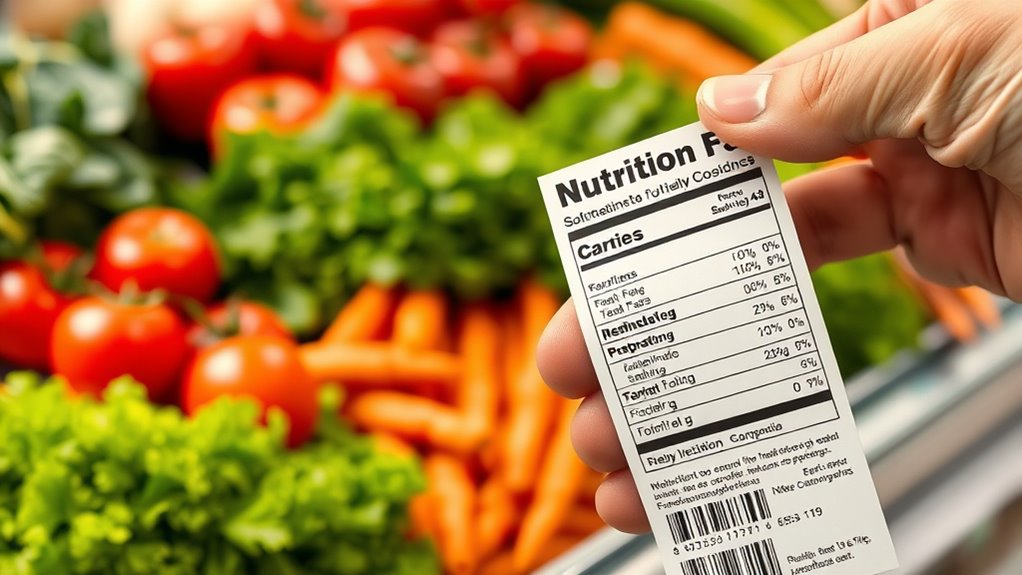
To make smarter choices when reading food labels, focus on identifying key nutritional information quickly. Start with the nutrition facts to find foods low in saturated fat, trans fats, sodium, and added sugars, which support healthy aging. Checking for necessary cookies can help ensure basic functionalities are maintained while browsing nutritional information efficiently. Being aware of the best heat pump features can also serve as an analogy for understanding how to select the most efficient and reliable food options based on their nutritional ratings. Check the serving sizes to ensure you’re comparing equal amounts and avoid overeating. Look for products high in dietary fiber and nutrients like calcium, vitamin D, and potassium, which promote bone health and overall well-being. Carefully read the ingredients list to spot hidden added sugars, unhealthy fats, and preservatives often found in processed foods. Understanding industry transformations can provide insight into how food production evolves and impacts nutritional quality. Paying attention to air purifier technology can help you understand how advanced features improve air quality and overall health. Consider the potential health benefits of herbal teas such as reducing inflammation and supporting relaxation, to enhance your overall wellness. Choosing items with higher %DV for essential nutrients helps meet your dietary needs.
Adapt Your Diet to Age-Related Changes

As you age, your body undergoes changes that require you to adjust your diet to maintain ideal health. You’ll need more nutrient-dense foods to compensate for decreased taste and appetite, ensuring you get essential vitamins and minerals. To support muscle maintenance, prioritize adequate protein intake, especially as muscle mass declines with age. Additionally, because nutrient absorption and metabolism slow down, dietary adjustments are crucial. Hydration becomes even more important since the sensation of thirst diminishes. Use this table to guide your focus:
| Nutritional Focus | Why It Matters | Practical Tip |
|---|---|---|
| Protein Intake | Maintains muscle | Include lean meats, beans |
| Hydration | Prevents dehydration | Drink water regularly |
| Vitamins & Minerals | Support overall health | Eat colorful, varied foods |
| Dietary Adjustments | Meet changing needs | Consult a nutritionist |
Furthermore, understanding how heat pumps transfer heat efficiently can inspire innovative solutions for energy use in health facilities, contributing to sustainable aging support environments. By applying principles from candle making techniques, such as optimizing heat transfer, healthcare facilities can improve energy efficiency and reduce costs. Additionally, integrating predictive modeling can help optimize resource allocation in aging care programs, ensuring that needs are met proactively. Recognizing the importance of nutrient timing can further enhance dietary strategies for older adults, maximizing nutrient absorption and effectiveness. Incorporating behavioral strategies can also support better dietary adherence among seniors.
Find Affordable Ways to Eat Healthy
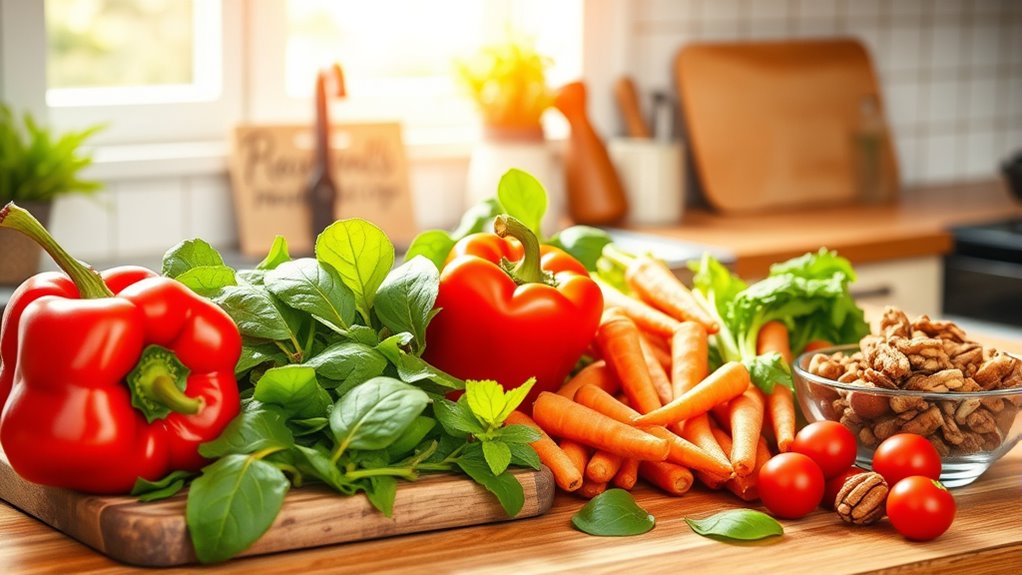
Finding affordable ways to eat healthy is essential for maintaining good nutrition on a budget. You can access assistance programs like SNAP and use tools like BenefitsCheckUp to explore your options.
Smart shopping—buying store brands, shopping in bulk, and choosing frozen or canned produce—helps you save money while keeping your diet nutritious. Additionally, utilizing meal planning strategies can help reduce waste and ensure you buy only what you need.
Budget-Friendly Food Choices
Eating healthy on a budget is achievable by making smart choices that save money without sacrificing nutrition. To find affordable meals, focus on budget-friendly foods like grains, beans, and seasonal produce.
Frozen produce is a cost-effective way to enjoy nutritious foods year-round, especially when bought without added salt or sugar. Bulk shopping helps you save by purchasing staples in larger quantities, reducing overall costs.
Keep an eye on grocery discounts, sales, and coupons to lower the price of healthy eating essentials. Planning meals and prepping ingredients can cut waste and ensure you always have nutritious foods ready.
Accessing Assistance Programs
Accessing assistance programs can make it easier to afford healthy foods, especially if you’re on a tight budget. Nutrition assistance programs like SNAP benefits provide around $158 monthly on average to help older adults buy nutritious foods.
To maximize food access, check your eligibility through tools like BenefitsCheckUp, which connects you to local resources. Many community organizations and food banks offer supplemental nutrition programs, providing free or discounted healthy foods for seniors facing financial hardship.
Grocery delivery services can also improve access, especially if mobility or transportation issues make shopping difficult. These services help you avoid impulse buys and save time while ensuring you get the nutrients you need.
Taking advantage of these programs and community resources can support your goal of healthy aging through better nutrition.
Smart Shopping Strategies
Smart shopping is essential for stretching your food budget while maintaining a healthy diet. Start by taking advantage of discounted produce, frozen, or canned items without added salt or sugar to get nutritious foods at lower prices.
Use SNAP benefits, which average around $158 monthly for seniors, to buy affordable fresh produce and other healthy options.
Incorporate bulk buying for staples like grains, beans, and nuts to reduce the cost per serving and ensure you always have nutritious foods on hand.
Consider grocery delivery or pickup services to avoid impulse purchases and stick to your budget-friendly shopping list.
Additionally, explore local farmers’ markets and community programs offering affordable or subsidized fresh produce, making healthy food choices more accessible and affordable.
Consult Professionals for Personalized Nutritional Guidance
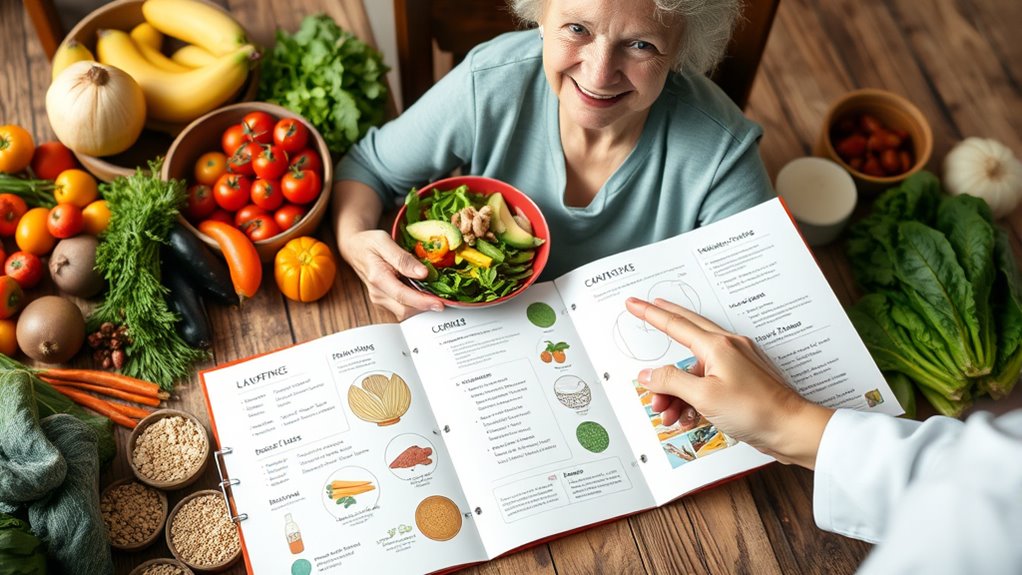
Consulting a registered dietitian or healthcare professional is essential for developing a personalized nutrition plan tailored to your specific health needs as you age. Their professional guidance helps address age-related health concerns, manage chronic illnesses, and prevent nutrient deficiencies such as vitamin D, B12, and iron. A dietitian’s advice ensures safe dietary modifications and accurate interpretation of food labels, empowering you to make healthier choices. Regular expert input improves adherence to dietary recommendations, boosting your overall well-being. Here’s a quick look at how personalized guidance supports your health:
| Aspect | Benefits |
|---|---|
| Age-related health | Tailored strategies for aging gracefully |
| Nutrient deficiencies | Targeted supplementation and diet tweaks |
| Dietary modifications | Safe, effective changes with professional advice |
| Food label interpretation | Informed choices aligned with your needs |
| Chronic illness management | Improved health outcomes through expert guidance |
Frequently Asked Questions
What Nutrition Is Good for Healthy Ageing?
You should focus on eating nutrient-rich foods that support your health as you age. Incorporate plenty of colorful fruits and vegetables for antioxidants.
Choose lean proteins and healthy fats to maintain muscle and skin health. Don’t forget foods high in calcium, potassium, vitamin D, and B12, or consider supplements if needed.
Increasing dietary fiber from whole grains and fruits helps digestion and reduces disease risk, keeping you vibrant and healthy.
What Is a Nutritional Recommendation for Aging Well?
To age well, you should focus on consuming nutrient-dense foods that support your overall health. Aim for about 1,300 mg of calcium daily to keep your bones strong, and include vitamin D-rich foods like fatty fish and fortified dairy to enhance calcium absorption.
Eat plenty of fruits, vegetables, whole grains, lean proteins, and fiber to boost your immune system, digestion, and reduce chronic disease risk.
Stay hydrated and limit processed foods high in sodium and sugar.
What Is the Single Best Diet for Healthy Aging?
You’re curious about the single best diet for healthy aging, and the answer might surprise you. It’s not about a miracle diet but a balanced, enjoyable way to eat.
The Mediterranean diet stands out because it emphasizes fruits, vegetables, healthy fats, and lean proteins. This approach supports your heart, brain, and bones, helping you stay healthier longer.
Embrace this tasty, nutrient-rich pattern for a vibrant, aging life.
How Can I Keep My Body Healthy in Old Age?
To keep your body healthy in old age, focus on eating a balanced diet rich in calcium, vitamin D, protein, and fiber.
Stay active with regular exercise like walking or strength training, and drink plenty of fluids to stay hydrated.
Manage any chronic conditions with medical guidance, avoid smoking and excessive alcohol, and protect your skin from sun damage.
These habits help preserve mobility, strength, and overall well-being as you age.
Conclusion
Just like a master painter creates a vibrant masterpiece, you can craft a healthy aging journey by making mindful food choices. Embrace variety, listen to your body’s changing needs, and seek expert guidance when needed. Remember, your nutrition story is uniquely yours—so take charge today. With each colorful plate, you’re not just fueling your body, but also painting a brighter, healthier future—one delicious, intentional bite at a time.
